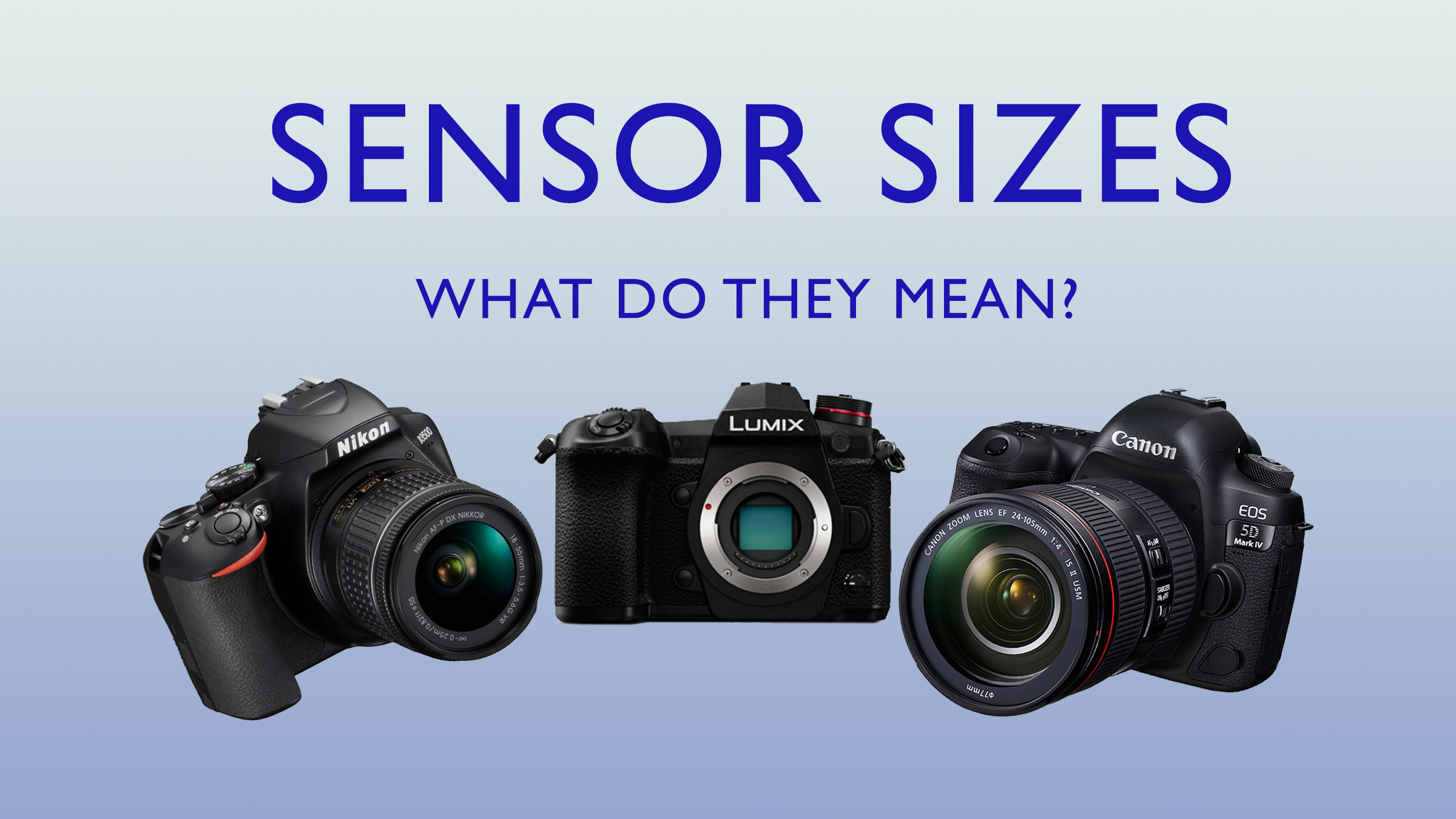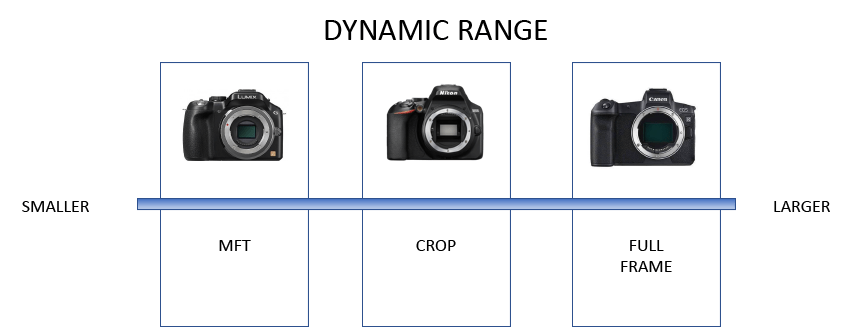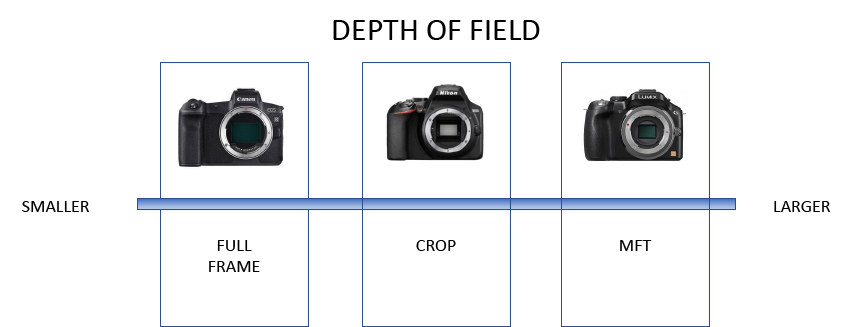July 28, 2021
Sensor Sizes – what do they mean?
What is the difference between a full-frame camera and a cropped sensor? How is it different to Micro Four Thirds?

There are a bewildering range of camera models if you’re new to photography, all using technical terms. Without knowing the jargon, it’s pretty challenging to know which is the best for you. One of the most significant sources of confusion is around sensor sizes. You’ll see names such as full-frame, cropped, APS-C or Micro Four-thirds. What on earth do all these things mean? Read on to find out why they make a difference and how you can decide which is best for you.
What are the sensor sizes?
To understand digital camera sensor sizes, we need to go back to the old days of film cameras. The film SLR’s were also known as 35mm cameras. The 35mm refers to the total width of a frame. It includes the photograph and the perforations that drive the spool of film through the camera. Each frame of the film is 36mm wide and 24mm tall. The diagonal difference from one corner to the other would be around 43mm. It is crucial because many photographers used a 50mm lens, which meant that what they saw through the lens was what they saw with their eyes. The lens wasn’t giving any kind of zoom as the film size and lens size was about the same.
If we now take that same 50mm lens and put it on a full-frame Digital SLR, what we would see through the eye-piece would be the same as the films cameras of old. However, attach it to a cropped-sensor camera and this time, you would see less of the image. The sensor gives the impression of zooming into the photo. On a Canon cropped-sensor camera, the zoom effect is 1.6x. On Nikon or Pentax cameras, there’s slightly less zoom with an impact of 1.5x. Micro four-thirds cameras, available from Panasonic, zoom even more with the crop at two times what we would see through a full-frame camera. You can see the relative sizes on the diagram below.

What does that mean for buying cameras?
There are advantages and disadvantages to all three sensor formats. It’s also quite difficult to make sweeping generalisations between, say, a 10-year-old full-frame camera versus the latest version cropped-frame sensor. The newer camera, will in all likelihood, perform better than the older one. However, when making distinctions let’s assume that we are comparing hypothetically similar cameras regarding the number of pixels and technology built into the processor.
Dynamic Range
When we talk about the dynamic range of the sensor, we mean the difference between the brightest and darkest things that the sensor can record. Typically, we can see about 25 stops of light. However, the latest cameras can only record a dynamic range of just under 15 stops.
The size of the sensor will determine the capability to record more light. All things being equal, the larger the sensor, the bigger each pixel is. As a result, bigger pixels can collect more light and so get better dynamic range performance. On the basis that the full-frame sensor is much bigger than the cropped or micro four-thirds equivalent, they will always have the best dynamic range performance.

Field of view
One of the most apparent differences between a full-frame sensor and its cropped cousins is how much of a scene is visible in the frame. Let’s go back to the 50mm lens that replicates what a full-frame camera will see. Put the same lens on a Canon APS-C cropped 1.6x sensor camera, then we would only see the equivalent of an 80mm lens on the full-frame camera. Add it to a micro-four-thirds camera, and you’d only see the same as if it was a 100mm lens on the full-frame camera.
The larger the sensor, the more of the scene will be seen in the equivalent lens. That’s great for landscape photographers. A 24mm lens on a full-frame camera includes far more of the scene than its cropped equivalent. The two images below show the scene on a full-frame camera (left) v the same scene on a cropped sensor.
However, if you are a wildlife photographer and want to get closer to the action, cropped sensors are the way to go. A 300mm lens on a cropped sensor will look as if you were using a 480mm lens on a full-frame camera.
Depth of field
DOF is an often misunderstood term in photography. It is the amount of an image that is ‘acceptably’ sharp. The larger the sensor is, the depth of field will appear to reduce. Larger sensor cameras need the photographer to get closer to the subject or use a more extended focal range to fill the frame with the subject. As a result, as the sensor size gets larger, you need to use progressively smaller aperture sizes to maintain the same depth of field.

Quality of image
For the purposes of this blog, when I talk about image quality, I’m talking about the amount of noise that is visible in the image. Again, I also need to be clear that I am comparing sensors that are equivalent to each other in everything but size. A cropped sensor will have a greater density of pixels than a full-frame sensor. The higher the pixel density, the more noise we are likely to see in an image. We tend to see noise in photographs that are shot on high ISO levels. Therefore, the larger the sensor, the better the quality of the image will be. Again, the health warning is that some camera manufacturers will have done other things in the software to try and reduce noise, so a straight test of comparing a 24 mega-pixel cropped frame sensor from manufacturer X versus a 24 mega-pixel full-frame camera from manufacturer Y may not be totally valid.

Size of camera
It’s pretty apparent that the bigger the sensor is, the bigger the box needs to be to fit it in. The majority of full-frame cameras will be bigger and heavier than their cropped equivalents. It’s not always the case, particularly as manufacturers make the conversion from mechanical to mirrorless.
Camera Cost
The final, and often, the decision-making difference between full-frame and cropped sensors is the amount they cost. There is currently a shortage of microchips globally, driving up the cost of anything that uses them. So, it makes sense that the larger the sensor is, the more it will cost. Most entry-level cameras have a cropped sensor because it is cheaper to manufacture. Before you indulge in buying a full-frame camera, think if the additional cost is worth the differences – it may not always be the case if you are a daylight wildlife shooter.
Give us your feedback
If you’ve got any questions or comments, leave them below. You can sign up for the Edinburgh Photography Workshop monthly newsletter, where you’ll get regular updates on exciting things happening in photography and some great tips. Sign up by clicking here.
About the author
As well as running Edinburgh Photography Workshop, Rich Dyson is a professional photographer. His photographs are regularly used in newspapers such as The Times, Guardian and Daily Telegraph. He also had two solo exhibitions and was featured in a members sponsored exhibition in the Scottish Parliament. You can see and buy his photography at richdysonphotography.com